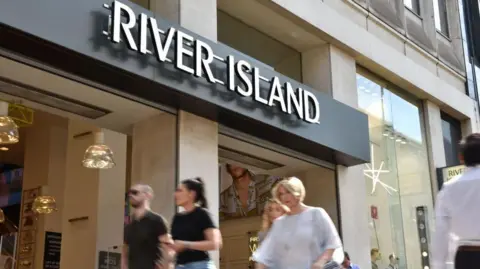### River Island’s Current Struggles: An Analysis of Challenges Faced by the Fashion Retail Chain
River Island, a well-known British fashion retail brand, is currently facing significant challenges that threaten its future. The chain, which has been a staple in High Street fashion since its inception, is at a critical juncture with its restructuring plans hinging on an important court ruling scheduled for early August 2025. This ruling is crucial for the company as it seeks to navigate through financial turbulence characterized by considerable losses and planned store closures.
In June 2025, River Island announced its intentions to close 33 shops across the UK, potentially putting hundreds of jobs at risk. Furthermore, the retailer is requesting rent reductions from landlords for an additional 71 stores. These moves are a response to shifting consumer behaviors that favor online shopping, combined with rising operational costs that have culminated in significant financial losses for the chain.
Catherine Shuttleworth, a retail consultant from Savvy Marketing, pointed out that River Island’s challenges are not unique but are shared across the retail sector. The company faces several underlying issues, including having stores located in less favorable areas and escalating costs of maintaining its expansive storefronts. According to her analysis, the “expensive portfolio of stores” is unsustainable at a time when consumer footfall is declining. Many of River Island’s older outlets are situated in locations that, while once bustling, have now become peripheral and less attractive to shoppers.
Founded in 1948 as the Lewis and Chelsea Girl brand before rebranding as River Island in 1988, the company experienced significant growth, historically dominating the UK High Street fashion scene alongside brands like Topshop. However, the landscape has shifted dramatically in recent years. As indicated by the retail chain’s most recent financial report, River Island reported a staggering £33.2 million loss, while sales plummeted by 19%. This decline can be attributed to the increasing competition within the fashion retail market, particularly from fast-fashion giants like Boohoo, as well as international competitors such as Shein and Temu.
Amid these struggles, River Island’s chief executive, Ben Lewis, highlighted the exacerbating impact of rising business costs and stiff competition on the company’s finances. The firm, which employs around 5,500 workers and operates over 230 stores, was one of the early adopters of online retailing, launching its digital platform in the late 1990s. Despite this innovative start, it has struggled to maintain its market position amid changing consumer preferences and intensified competition.
Looking forward, creditors will begin voting on River Island’s restructuring proposals on August 4, with a critical decision from the High Court expected soon after on August 7. The management states that these measures are necessary to achieve a more secure financial footing. Nevertheless, industry experts suggest that River Island’s operational deficiencies stem from decisions made—or lack thereof—over the years. Nick Sherrard, managing director of Label Sessions, emphasized that the retailer now needs to address its approach to customer engagement and brand loyalty. He observed a distinct lack of trust in River Island from stakeholders, indicating a need for a stronger connection with its customer base.
Furthermore, as the retail environment continues to evolve, River Island’s leadership must reevaluate its brand strategy. Remy Farrell, fashion editor for Who What Wear, pointed out the importance of rebranding in a challenging economic climate. The current trend favors brands that offer foundational products rather than those that depend on fleeting fashion trends. As River Island navigates these turbulent waters, the crucial question remains: Who is their target market, and what value does the brand provide to consumers today?
In conclusion, River Island’s future is precariously balanced on the outcomes of upcoming court decisions, alongside a need for strategic reevaluation and rebranding. As it faces the mounting pressure of market competition and internal financial strains, the company must forge a path forward to reinvigorate itself, cement its customer base, and adapt to the shifting dynamics of the fashion retail landscape.












